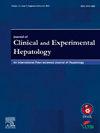Challenges and Recent Advances in Diagnosing Wilson Disease
IF 3.3
Q2 GASTROENTEROLOGY & HEPATOLOGY
Journal of Clinical and Experimental Hepatology
Pub Date : 2025-02-22
DOI:10.1016/j.jceh.2025.102531
引用次数: 0
Abstract
Wilson disease (WD) is a rare autosomal recessive disorder caused by ATP7B gene mutations, leading to pathological copper accumulation that primarily affects the liver, brain, and eyes. Diagnosing WD remains a significant challenge due to its highly variable clinical presentation, which ranges from asymptomatic biochemical abnormalities to acute liver failure and severe neuropsychiatric manifestations. Traditional diagnostic markers, such as serum ceruloplasmin, urinary copper excretion, and liver biopsy, lack sufficient specificity and sensitivity, often leading to delays in diagnosis and misclassification. Additionally, the absence of a single gold-standard test and the overlap with other hepatic and neurological disorders further complicate early detection.
Recent advances in diagnostic techniques offer promising solutions to overcome these limitations. Novel biomarkers, including relative exchangeable copper (REC) and ATP7B protein quantification in dried blood spots have demonstrated improved accuracy in distinguishing WD from other conditions. Advanced imaging modalities, such as anterior segment optical coherence tomography (AS-OCT), quantitative susceptibility mapping (QSM), and copper-64 positron emission tomography imaging provide noninvasive tools for detecting early disease-related changes. Furthermore, next-generation sequencing (NGS) enhances genetic screening, facilitating earlier diagnosis, and family screening.
A comprehensive approach integrating conventional and emerging diagnostic methodologies is essential for improving early detection and patient outcomes. Greater awareness of the limitations of traditional tests and the incorporation of novel biomarkers and imaging techniques into clinical practice can help refine diagnostic accuracy, reduce delays, and optimize treatment strategies for WD.
威尔逊病诊断的挑战和最新进展
威尔逊病(WD)是一种罕见的常染色体隐性遗传病,由ATP7B基因突变引起,导致病理性铜积累,主要影响肝脏、大脑和眼睛。诊断WD仍然是一个重大挑战,因为它的临床表现变化很大,从无症状的生化异常到急性肝衰竭和严重的神经精神表现。传统的诊断指标,如血清铜蓝蛋白、尿铜排泄、肝活检等,缺乏足够的特异性和敏感性,往往导致诊断延误和误分类。此外,缺乏单一的金标准测试以及与其他肝脏和神经疾病的重叠进一步使早期检测复杂化。诊断技术的最新进展为克服这些限制提供了有希望的解决方案。新的生物标志物,包括干血斑中相对可交换铜(REC)和ATP7B蛋白的定量,已经证明了区分WD和其他疾病的准确性。先进的成像方式,如前段光学相干断层扫描(as - oct)、定量敏感性成像(QSM)和铜-64正电子发射断层扫描成像,为检测早期疾病相关变化提供了无创工具。此外,下一代测序(NGS)增强了基因筛查,促进了早期诊断和家庭筛查。综合传统和新兴诊断方法的综合方法对于改善早期发现和患者预后至关重要。提高对传统检测方法局限性的认识,将新型生物标志物和成像技术纳入临床实践,有助于提高WD的诊断准确性,减少延误,并优化治疗策略。
本文章由计算机程序翻译,如有差异,请以英文原文为准。
求助全文
约1分钟内获得全文
求助全文
来源期刊

Journal of Clinical and Experimental Hepatology
GASTROENTEROLOGY & HEPATOLOGY-
CiteScore
4.90
自引率
16.70%
发文量
537
审稿时长
64 days
 求助内容:
求助内容: 应助结果提醒方式:
应助结果提醒方式:


